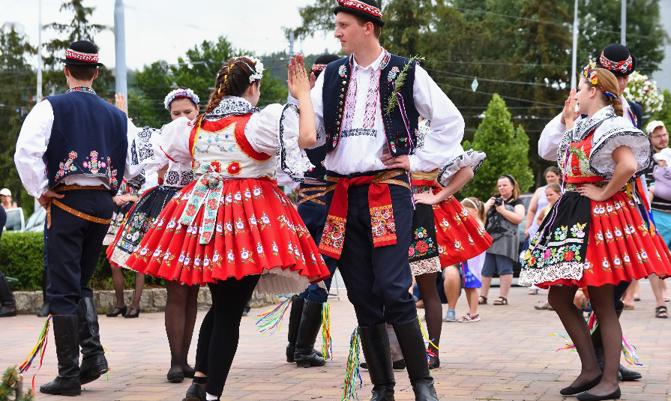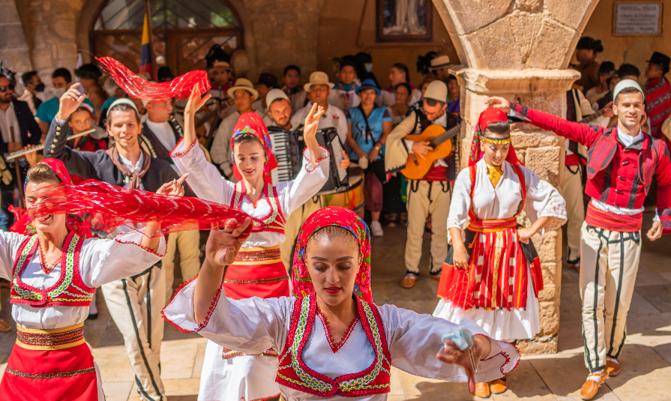Dance
Polska
The Polska seems to be the oldest dance collected in Sweden. This musical form found its roots in Sweden in the seventeenth century. Famous Swedish dance, Polska is a couple of dances composed of two parts: the procession, where couples walk one behind the other counterclockwise, and the turning part. Dancers must tame this curious three-times rhythm where the emphasis is on times 1 and 3 of the measure. Time 2 is a suspension. It moves across regions, according to the music within the measurement. The couple walks through in two steps. The boy, for example, does a walking step on the left foot at time 1, then a second step with the right foot on the third time, and continues as much as he wants. Regarding the turns, the boy must have the initiative. He goes in front of his partner back in the common direction. The embracing couple turns clockwise on the tree time rhythm and progresses as the promenade counterclockwise. The feet are between each other which allows a stable rotation. This is a quiet dance, steps are suspended, and the movement is fluent and smooth.
Rondeau
Rondeau is a traditional dance from Pays des Landes de Gascogne.We find different variations, mainly the rondeau chain and rondeau couples.Like many dances, the rondeau is heir to branles from the Renaissance. This is why the most faithful to the traditional form is a shaped chain. Under the influence of modernity, the chain has evolved into groups of dancers in smaller numbers, until the ultimate form of the couple. As a couple of forms, the procession continues to move in the direction of clockwise, as in the chained form.
Several short chains from 5 to 7 dancers stand side by side, hand in hand, arms along the body, forearm raised in front, perpendicular to the body axis. Men spend their arms over those of women (or left arm below, right arm above)
Rond de Saint-Vincent
The “Rond de Saint-Vincent” is an old dance coming from Bretagne, from Saint-Vincent-sur-Oust in Morbihan. Once rather confidential, it was popularized during the 90s and nowadays, the Rond de Saint-Vincent is one of the most practised dances in fest-noz and bal folk.
POLKA
The polka originated from some of the dances popular in Bohemia (Czech Republic). The origin of the dance is shrouded in legend. The most likely hypothesis is from the Bohemian historic Alfred Waldau: “The music teacher Jesep Neruda, who taught in Prague, found himself once watching a peasant dance and song. He retraced its steps and that melody which came up with a dance polka in fact, that he launched out first in Prague and then in Baden, where he achieved incredible success. ”In 1835 he included the polka in the repertoire of a Bohemian military band. The success of the dance subsequently infected the whole of Europe. The word “polka” derives from “pulka,” the Czech word for “half”, referring to the step “chasse” used as a basic step in the dance.
Mazurka
Mazurka originates from a polish dance called Mazurek which was widespread in many ballrooms in the 19th century. It is a dance for couples which arrived in France in the nineteenth century. First was a ballad in Paris salons, therefore, it was taken up by the notables of the province and spread throughout the country. The Mazurka is very enjoyable to dance to and is also very beautiful to look at. The dance is not limited to basic steps. It is full of variations and learning it requires a lot of practice, but the efforts will be rewarded.
Impair Scottish
The impaired Scottish is not traditional compared to waltz or polka or other couple dances. It is a dance that emerged in the context of current practice folk-trad, in 2007, created by Gerard Gordon (from the band Parasol). The impaired Scottish is a couple of dances such as waltz, polka, Scottish, etc)It starts in a direction to the right for women and left for men. You do a Scottish step (to the right for women and left for men)
Hanter-dro
Hanter-dro is a native Breton dance from pays vanitas. As the gavotte, this is a dance where the dancers stand firmly and it is a feet dance (unlike many sonnetises dances like ridées or an-dro that can be considered as arm dances). Literally, the Breton word “hanter-dro” means about-turn in French. Sometimes named hanterdañs, then it means half-dance. the hunter-dro drift of branles from the Renaissance. Fashion changing, during the mid-nineteenth century, this dance was moribund and was gradually supplanted by laridés which drifted from it over the second half of the nineteenth century. Young preferred ridées because these dances were jumpier.


